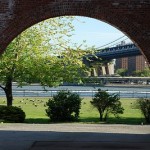
Brooklyn Heights Ass'n
The BHA has provided the following information about these legal actions and their background:
Plaintiffs, represented by Gibson, Dunn & Crutcher, brought these suits after obtaining documents through the Freedom of Information Law which showed that City and State officials launched a secret plan to remove the Tobacco Warehouse from the park’s map so that it could be given to a private organization for free and for its sole and permanent use.
“The purpose of having protected parkland is to guard it for open access by everyone, regardless of background or ability to pay. After 5 years of programming with many events by a diverse collection of groups with varied missions, including art, cultural, musical, and recreational, the government has secretly turned over the keys to a monopoly of one,” said Jane McGroarty, President of the Brooklyn Heights Association. McGroarty said the lawsuit was the only remaining option to save the Tobacco Warehouse after her plea to the National Park Service (in July 2010) went unanswered.
“People have enjoyed this lovely space for years as an integral part of the park and the views,” said Rep. Nydia M. Velázquez (D-NY). “We must not only keep the Tobacco Warehouse in the Park, but we should look for ways to expand access to its flexible open public use.”
The Tobacco Warehouse is a 25,000 square foot unroofed historic space that was saved from demolition twice in the past 40 years. The community convinced the government to spend more than $2 million to renovate the Tobacco Warehouse and the Fulton Ferry Park, where the Warehouse resides and as a result, the Warehouse was host to many outdoor events – dance performances, concerts, family and children’s events.
“The New York Landmarks Conservancy is concerned that proper procedures were not followed when the Tobacco Warehouse was removed from the park. When the Conservancy was involved in saving the Warehouse years ago, the State invested in the building and treated it as a feature of the park,” said Peg Breen, President of the New York Landmarks Conservancy, a plaintiff in the federal action.
State Senator Daniel Squadron also expressed his concerns, “I’ve long said that transparency and community input are crucial as we work together to help Brooklyn Bridge Park reach its full potential. The Tobacco Warehouse is a big part of that potential, and a unique community amenity — the process for determining its use must adhere to these principles. If true, the issues being raised today are disturbing and call the process into further question; they must be dealt with swiftly.”
“The Tobacco Warehouse has great historical significance and has been saved repeatedly over the years by some of our local community groups. In light of this new information, I believe it should remain as is — a stabilized architectural ruin programmed as a multi-purpose space accommodating a variety of activities,” added Assemblymember Joan Millman.
City Councilmember Steve Levin said, “As the New York City Councilmember who represents Brooklyn Bridge Park, I have consistently opposed the issuing and awarding of the Tobacco Warehouse RFP. The Tobacco Warehouse is a historic landmark and a public treasure. I continue to believe strongly that the Tobacco Warehouse should remain public parkland to the benefit of the entire community.”
Joan Zimmerman, President of the Fulton Ferry Landing Association said, “The process was manipulated by unelected bureaucrats to get the results they — not the people — wanted. This isn’t the way a democracy is supposed to work.”
Update: For the really wonkish (Publius, are you with me?), Dumbo NYC has what’s supposed to be the nitty-gritty of what went on amongst the defendants in the lawsuits. Curbed’s Sara Polsky read it, but still wants an explanation.


